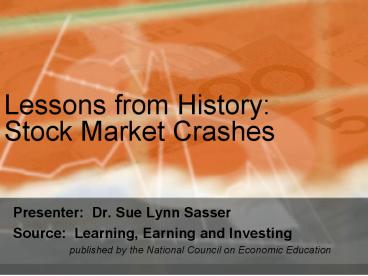Lessons from History: Stock Market Crashes - PowerPoint PPT Presentation
Title:
Lessons from History: Stock Market Crashes
Description:
Stock Market Crashes. Presenter: Dr. Sue Lynn Sasser. Source: Learning, ... How did Fed policy help prevent a recession after the stock market crash of 1987? ... – PowerPoint PPT presentation
Number of Views:267
Avg rating:3.0/5.0
Title: Lessons from History: Stock Market Crashes
1
Lessons from History Stock Market Crashes
- Presenter Dr. Sue Lynn Sasser
- Source Learning, Earning and Investing
- published by the National Council on
Economic Education
2
Concepts
- Causes and effects of stock market crash in 1929
- Causes and effects of stock market crash in 1987
- The role of the Federal Reserve and monetary
policy
3
Objectives
- Develop and present posters about the crashes
- Compare the two crashes
- Explain the Feds role and how is contributed to
different outcomes in the two crashes
4
Materials
- Copies of the information sheets
- 8 large pieces of construction paper or butcher
paper - 3 or 4 markers for each group of students
5
What is a stock market crash?
- Stock prices drop A LOT!
- Price drops are sudden and unexpected
- Crashes create panic
- People lose money they have invested in stocks
6
U.S. Stock Market Crashes
- October 1929
- October 1987
7
Questions
- How were the causes of the 1929 crash similar to
the causes of the 1987 crash? - Why did many people sell their stock at the same
time?
8
- What happened after the 1929 crash, compared to
what happened after the 1987 crash?
9
- How did the Fed react to the two crashes?
10
- Given what happened in both crashes, do you think
there will be additional crashes in the future?
11
An economic perspective
- Economists agree that supply and demand forces
may lead to future crashes because stock market
prices are based, in great part, on
expectations. - When investors believe stock prices will
increase, it increases the demand for stocks.
12
- This increased demand continues until stock
prices become too high for the value of the
related corporation. - Over valued stocks create market situations
called speculative bubbles and bubbles can
burst! - Bubbles burst when investors expect prices to
stop increasing.
13
- Over valued stock prices result in excess
supply of stocks, which causes prices to fall.
The greater the perceived over value, the greater
the fall. - When investors decide to leave the market at the
same time, little can be done to prevent the
markets from falling.
14
Review
- How did Fed policy help create the Great
Depression after the stock market crash in 1929? - How did Fed policy help prevent a recession after
the stock market crash of 1987?
15
For more information on this lesson.
- Go to http//lei.ncee.net
- Or, attend a Learning, Earning and Investing
workshop - www.econisok.org
16
Contact information
- Dr. Sue Lynn Sasser
- Executive Director
- Oklahoma Council on Economic Education
- 100 N. University Drive, Box 103
- Edmond, OK 73034
- 405.974.5627
- ssasser_at_ucok.edu































